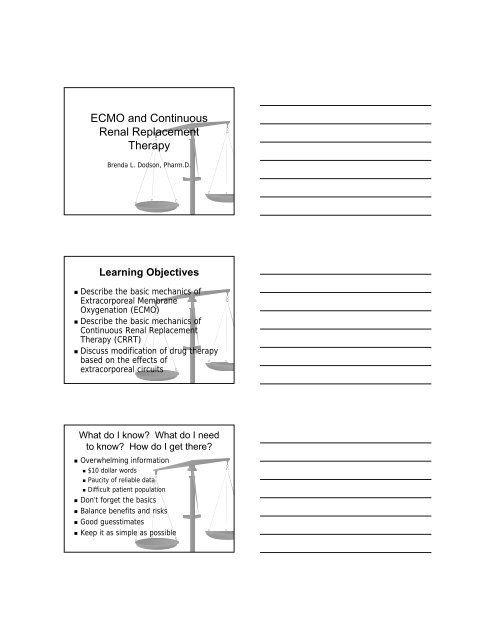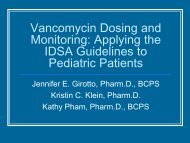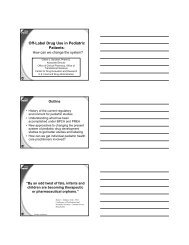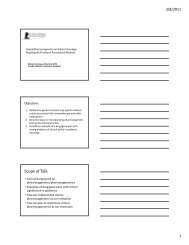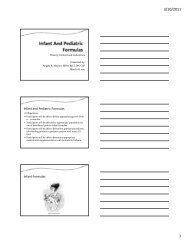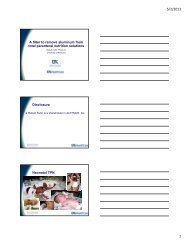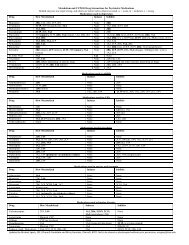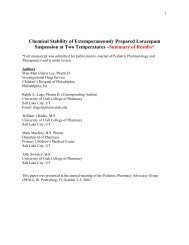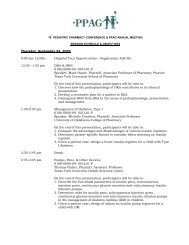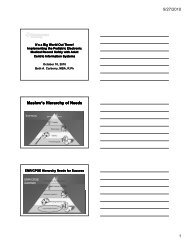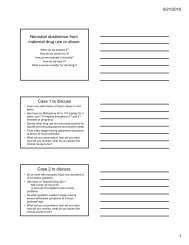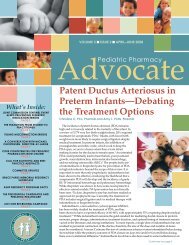ECMO and Continuous Renal Replacement Therapy - PPAG
ECMO and Continuous Renal Replacement Therapy - PPAG
ECMO and Continuous Renal Replacement Therapy - PPAG
- No tags were found...
Create successful ePaper yourself
Turn your PDF publications into a flip-book with our unique Google optimized e-Paper software.
<strong>ECMO</strong> <strong>and</strong> <strong>Continuous</strong><strong>Renal</strong> <strong>Replacement</strong><strong>Therapy</strong>Brenda L. Dodson, Pharm.D.Learning Objectives• Describe the basic mechanics ofExtracorporeal MembraneOxygenation (<strong>ECMO</strong>)• Describe the basic mechanics of<strong>Continuous</strong> <strong>Renal</strong> <strong>Replacement</strong><strong>Therapy</strong> (CRRT)• Discuss modification of drug therapybased on the effects ofextracorporeal circuitsWhat do I know? What do I needto know? How do I get there?• Overwhelming information• $10 dollar words• Paucity of reliable data• Difficult patient population• Don’t forget the basics• Balance benefits <strong>and</strong> risks• Good guesstimates• Keep it as simple as possible
<strong>ECMO</strong> - Basics• Extracorporeal Membrane Oxygenation• Break it down• Extracorporeal - Not in the body• Something to do with a membrane• Oxygenation occurs• Prolonged form bypass used to supportpatients with life-threatening potentiallyreversible respiratory or cardiac failureunresponsive to optimal conventionaltherapy• Introduced in 1975• ECCO 2 R, ECLS, ECLA, <strong>ECMO</strong><strong>ECMO</strong> - Neonates• Neonatal population• Has been used extensively• Treat severe respiratory failure• Meconium aspiration syndrome• Congenital diaphragmatic hernia• Persistent pulmonary hypertension• Respiratory distress syndrome• Sepsis• Now less often necessary due to advent ofinhaled nitric oxide therapy <strong>and</strong> Hi-FrequencyOscillatory Ventilation (Hi-FOV)• Success rate of ~80%<strong>ECMO</strong> - Pediatrics• Pediatric population• ~1990• ~55% survival for respiratory failure• ARDS• Viral/bacterial pneumonia• Sickle cell disease• Asthma• Other conditions• Severe sepsis• Near drowning• Pulmonary embolism• Pulmonary contusion• Severe, reversible myocardial dysfunction
<strong>ECMO</strong>• Purpose of <strong>ECMO</strong>• Provides carbon dioxide removal <strong>and</strong>oxygenation of venous blood• Replaces broken lungs• Both VA <strong>and</strong> VV• Can remove deoxygenated blood from thevenous system <strong>and</strong> return of oxygenatedblood into the arterial circulation• Replaces broken hearts• VA• Patients still intubated <strong>and</strong> on ventilatorysupport to prevent lung collapse• Minimize barotrauma <strong>and</strong> volutrauma fromhigh pressuresKinds of <strong>ECMO</strong>• Venovenous (VV) – Pulmonary• Venous (deoxygenated) blood removal fromright internal jugular (RIJ) vein <strong>and</strong> return ofoxygenated blood to (RIJ)• Venoarterial (VA) – Pulmonary <strong>and</strong> Cardiac• Venous (deoxygenated) blood removed fromRIJ or femoral vein <strong>and</strong> return of oxygenatedblood to right common carotid artery orfemoral artery, nonpulsatile flow• Bypasses heart <strong>and</strong> pulmonary circulation• Not 100% bypass…still allows some venous bloodto proceed through the normal heart/lungcirculatory pattern<strong>ECMO</strong> – What’s Happening?• What happens in the circuit• Tubing – carries blood• Collapsible reservoir/bladder• Captures air bubbles <strong>and</strong> clots, drug administration• Roller pump• Advances blood through the circuit to the oxygenator• Membrane Oxygenator (Silicone)• “Roll of paper towels”• “Artificial lung” for CO 2 removal <strong>and</strong> oxygenation of blood• Sweep gas to prevent excessive CO 2 removal <strong>and</strong> metabolicalkalosis• Heater• Prior to being returned to the body• In patients with renal dysfunction or fluid overload, ahemofiltration unit can also be added to the circuit
What do we know about drugson <strong>ECMO</strong>?• Few studies• Limited by small sample sizes, differencesin <strong>ECMO</strong> techniques <strong>and</strong> equipment, <strong>and</strong>complexity of patients with lack of uniformdiagnosis• Clinical judgment• Benefits versus risk• Toxicity profile• Monitoring capabilitiesHow do critically ill patientschange things?• Complex• Patient effects• Volume of Distribution• Fluid overload• Hypoalbuminemia• <strong>Renal</strong> function• Sometimes impaired or becomes impaired• Diuresis• Overall organ function• Hypoxia
How does <strong>ECMO</strong> changethings?• Complex• <strong>ECMO</strong> circuit effects• Adsorption• Saturable, depends on frequency of circuit changes• To tubing• To oxygenator• Volume of distribution• Blood product volume for initial prime <strong>and</strong> dailymaintenance of coagulation parameters• Administration of medications into circuit• Pre-, intra-, post- bladder locations• HemofiltrationDrug Loss in Circuit• Adsorption• Tubing•Albumin administration to circuitbefore blood prime helps to minimize• Oxygenator•Not well studied•Variable effects•Saturable•Depends on circuit change frequency
Volume of Distribution• <strong>ECMO</strong> requires the addition exogenous bloodproducts to prime the circuit• Increases circulating blood volume <strong>and</strong> overallvolume of distribution• Some cases more than doubles normal blood volume• Can have effects on the volume ofdistribution of medications• More significant in neonates than in pediatric<strong>and</strong> adolescent patients• Especially significant for drugs primarilydistributed in the central compartment• Low population V dCHB prime packs• Albumin• Shown to decrease drug adsorption• An electrolyte solution <strong>and</strong> Albumin are added tocircuit after the CO 2 prime <strong>and</strong> before the bloodproduct prime• Neonatal Pac• 500 mL CMV negative PRBCs
Heparin• Heparinization to prevent clotting of the circuit• ACT – activated clotting time• 180-200 seconds during <strong>ECMO</strong> (normal 90-100 seconds)• Goal can be lowered if patient is bleeding• Heparin clearance reported to be increasedduring <strong>ECMO</strong>• ?binding/inactivation to circuit• CHB: 30 units/kg IV x1, then begin ~10units/kg/hr <strong>and</strong> titrate as necessary +/-intermittent doses to keep ACT (Q1h checks)180-200 seconds• Maintenance of platelet count, fibrinogen, <strong>and</strong>clotting factors necessary, QOD head ultrasoundAminocaproic Acid• Antifibrinolytic used in patients at risk of IVH• Gestational age
Sedatives <strong>and</strong> Analgesics• Anesthetic doses given during cannulation• Maintenance Therapies• Opioids• Fentanyl – shown to have significant binding to circuit (~70%)• Morphine – also shown to bind to circuit, but to a lesser extent• CHB – morphine infusion started at 0.05 mg/kg/hr, titrated• Benzodiazepines• Lorazepam – can be used in intermittent doses• Midazolam – circuit binding• CHB – midazolam infusion started at 0.05 mg/kg/hr, titrated• Barbiturates: Pentobarbital 2-6 mg/kg IV Q2h PRN• Constant titration• Consider weaning as able <strong>and</strong> empirically decreasinginfusion rates when <strong>ECMO</strong> is discontinuedChemical Paralysis• Not routinely administered• Use of muscle relaxants is indicated under thefollowing circumstances• During conditioning or cycling• Acutely when patient movement interferes withvenous return• Particularly during VV <strong>ECMO</strong>• In the rare situation when excessive patientmovement threatens accidental decannulation.• Pancuronium 0.1-0.2 mg/kg IV• Cisatracurium 0.2 mg/kg IV• <strong>Continuous</strong> infusionsAntiepileptics• Fosphenytoin/Phenytoin• Typically difficult to achieve therapeutic levels inneonatal population• Not often used• Phenobarbital• Most commonly used• <strong>ECMO</strong> circuit shown to have significant effects -increased elimination• Begin with typical doses <strong>and</strong> adjust as necessary• Midazolam/Lorazepam on board
Cardiovascular• Vasoactive infusions routinely used• Titrate to effect• Dopamine• Epinephrine• Norepinephrine• Dobutamine• Milrinone• Consider access• ElectrolytesFEN• Replace electrolytes as necessary• Allows for optimal efficacy of diuretics• Correct metabolic acidosis• Tromethamine• Hypernatremia• Alternate to sodium bicarbonate in hypernatremia• Beware renal function• PN/enteral feeds• Intralipids are okay• NTE 2 g/kg/day to prevent accumulation <strong>and</strong> embolismin circuit.GI• Stress Ulcer Prophylaxis• Ranitidine• Studies suggest greater elimination on<strong>ECMO</strong>• Typical dosing, most often added to PN• <strong>Renal</strong> function• Monitor gastric pH• Proton Pump Inhibitors• Pantoprazole, Omeprazole• Monitor gastric pH
Diuretics/Hemofiltration• Fluid overload is common problem• Furosemide• Higher doses secondary to loss in circuit• Up to 2 mg/kg IV Q8h• Infusions 0.05 – 0.2 mg/kg/hr• Chlorothiazide• Up to 20 mg/kg IV Q12h• Give 30 minutes before furosemide• Spironolactone• Hemofiltration• Ultrafiltration – convective removal of medicationspossible• Maintain urine outputInfectious Diseases• Broad-spectrum antibiotics• Prophylaxis <strong>and</strong> treatment• Gram negative coverage• Gram positive coverage• Listeria monocytogenes• Infectious complications• Cannulation process• Prolonged exposure to the catheters• Manipulation of the <strong>ECMO</strong> circuit• Immune function of the patient• Children’s Hospital Boston Neonatal <strong>ECMO</strong>• Ampicillin, Oxacillin, CefotaximeInfectious Diseases• Gentamicin• Most well studied drug• Studies indicate decreased clearance <strong>and</strong>increased volume of distribution• 2.5 mg/kg IV Q18h suggested• Typically no change necessary – monitor peak<strong>and</strong> troughs <strong>and</strong> increase dose or extendinterval as appropriate• 35 weeks gestational age: 4 mg/kg IV Q24h• 1 month – 10 yo: 2.5 mg/kg IV Q8h• >10 yo: 2 mg/kg IV Q8h
• VancomycinInfectious Diseases• Studies indicate decreased clearance <strong>and</strong> increasedvolume of distribution• 15 mg/kg IV Q18h suggested• 15 mg/kg IV Q8-12h – monitor trough levels <strong>and</strong> adjust asappropriate• Meropenem, Fluconazole, Ambisome®,Piperacillin/Tazobactam, Clindamycin• Balance risks of underdosing with expectedtoxicities• Prioritization<strong>ECMO</strong> - <strong>Renal</strong> Function• Usually some evidence ofcompromise• Circulating vasoactive substancesmay be stimulated as blood passesthrough the oxygenator•Arachidonic acid metabolites <strong>and</strong>renin•Causes reduction of renal blood flow• Aggressive diuretic therapy• <strong>Renal</strong> hypoxia prior to or during<strong>ECMO</strong>Basics - CRRT• What is CRRT?• <strong>Continuous</strong> <strong>Renal</strong> <strong>Replacement</strong><strong>Therapy</strong>• Any continuous mode ofextracorporeal solute or fluidremoval• <strong>Continuous</strong> hemofiltration was firstused in 1977 for diureticunresponsive fluid overload
What happened to.….• SCUF – Slow <strong>Continuous</strong> UltraFiltration• Convective removal, no replacement fluid• CAVH – <strong>Continuous</strong> ArterioVenous Hemofiltration• Convective removal, patient blood pressure determinesflow, 2 vessels, replacement fluid• CVVHD – <strong>Continuous</strong> VenoVenous HemoDialysis• Diffusive removal, pump driven, usually no replacementfluid, dialysate delivered countercurrent to blood• CVVH – <strong>Continuous</strong> VenoVenous Hemofiltration• Convective removal, pump driven, replacement fluid• CVVHDF – <strong>Continuous</strong> VenoVenousHemoDiaFiltration• Diffusive + Convective Removal, pump driven,replacement fluid, dialysate delivered countercurrent tobloodCRRT - Principles• Blood flows through a semipermeablemembrane driven either by patient bloodpressure (AV mode) or by a peristalticpump (VV mode)• Semipermeable membrane of the filter istypically synthetic <strong>and</strong> high-flux• Solute clearance can be achieved bydiffusion, convection, or a combinationDiffusion• Solutes such as urea, phosphate, <strong>and</strong> uremictoxins are driven by their electrochemicalgradient to move across the membrane into thesterile dialysate, which is runningcountercurrent to blood on the other side of themembrane capillaries• Different than IHD• CRRT – dialysate flow is slow• Typically 0.6 - 2 L/hr• IHD – dialysate flow is fast• Typically 500 mL/min or 30 L/hr
Convection (Hemofiltration)• Solute movement across the membrane is drivenby solvent drag• Solvent (plasma water) is pushed across themembrane by the filtrating pressure generatedby blood flow• Identical to glomerular ultrafiltration• High-flux membranes have permeability cutoff pointsof up to 30,000 daltons• Solvent takes all plasma water solutes• Combination becomes the effluent or ultrafiltrate (UF)from the filter which is discarded• UF – replaced with a fluid that contains thenecessary electrolytes <strong>and</strong> volume but none ofthe toxinsHemodiafiltration• Diffusion + convection• Improved clearance of large <strong>and</strong> smallmolecules• Removal of excess fluid<strong>Replacement</strong> Fluids• Replace fluid volume <strong>and</strong> electrolytes• Lactate-based <strong>and</strong> bicarbonate-basedsolutions• Normocarb HF solutions• Sodium 140 mEq/L• Magnesium 1.5 mEq/L• Chloride 116.5 mEq/L (25) vs. 106.5 mEq/L (35)• Bicarbonate 25 mEq/L (25) vs. 35 mEq/L (35)• Can add Potassium Chloride, PotassiumPhosphate
• CRRTCRRT vs. IHD• Volume control is continuous <strong>and</strong> adaptable• Prevent/treat volume overload without inducing acute volumedepletion• Prevent IHD-associated surge in intracranial pressure• Benefits in cardiac disease <strong>and</strong> renal dysfunction due todecreased volume overload, improved urine output,decreased LEDV• Appropriate fluid resuscitation, administration ofblood products, <strong>and</strong> nutrition• Rapid improvement <strong>and</strong> control of metabolic acidosis• More rapid <strong>and</strong> reliable control of serum electrolytes• Uremic control is superior• Frequency of dialysis• Dose of IHD can be increased, although cannot ever reachthe levels obtained in CRRTOther Considerations• <strong>Continuous</strong> anticoagulation therapy• Heparin vs. Citrate• Electrolyte Replenishment• Phosphorus• Calcium• CostPharmacokinetics - Basics• Total body clearance (TBC)• Sum of clearances from different sites in thebody• Hepatic, renal, other metabolic pathways,extracorporeal• If renal clearance is normally
Factors DeterminingExtracorporeal Removal• Protein binding• Free circulating fraction of drug is available for removalby extracorporeal means• pH, heparin therapy, hyperbilirubinemia, relativeconcentration of drug <strong>and</strong> protein, uremia, other drugs• Volume of distribution• Indirectly proportional to free drug in vascularcompartment• IHD vs. CRRT• IHD - drugs with large V d <strong>and</strong> high clearance during high-fluxIHD will have a rapid decrease in plasma level of freecirculating drug, but only a small amount of the body’s drugcontent is removed• Plasma concentration will be restored between IHD sessions• CRRT - less acute changes in plasma concentration because ofcontinuous redistribution of drugFactors DeterminingExtracorporeal Removal• Molecular weight• Most drugs have molecular weight 1500 daltons (vancomycin 1448 daltons)• Conventional dialysis membranes clear molecules
Adjustments• Critically ill patients at risk for overdose<strong>and</strong> drug accumulation, but also at risk forunder dosing which may be lifethreatening• How to Adjust?• D = D N (Cl ANUR + Q E x C E /C P /Cl N• Cl CRRT = f u x (Q UF + Q D x Kd rel )• D E = D N x [P x + f u x (Q UF + Q D x Kd rel )/Cl N ]• Cl CRtot = Cl CRren + Cl CRfiltYeah, Right!• Use published references• CAVH – often recommendation is to usedosage adjustments for creatinine clearanceof 10-50 mL/min/1.73 m 2• Therapeutic drug monitoring wheneverpossible to direct therapy• Clinical effect• Risk vs. benefit• Expected toxicity• Best guessReferences• Mols G, Loop T, Geiger K, Farthmann E, Benzing A. Extracorporeal membrane oxygenation: aten-year experience. Am J Surg. 2000;180:144–154• Kellum J, Mehta R, Angus D, Palevsky P, Ronco C. The first international consensus conferenceon continuous renal replacement therapy. Kidney International 2002;62:1855-63• Petroni K, Cohen N. <strong>Continuous</strong> <strong>Renal</strong> <strong>Replacement</strong> <strong>Therapy</strong>: Anesthetic Implications. AnesthAnalg 2002;94:1288–97• Ronco C, Bellomo R, Ricci Z. <strong>Continuous</strong> renal replacement therapy in critically ill patients.Nephrol Dial Transplant 2001;16 Supp 5:67-72• Ronco C, Bellomo R, Kellum J. <strong>Continuous</strong> <strong>Renal</strong> <strong>Replacement</strong> <strong>Therapy</strong>: Opinions <strong>and</strong>Evidence. Advances in <strong>Renal</strong> <strong>Replacement</strong> <strong>Therapy</strong> 2002;9(4):229-44.• Goldstein S. Overview of Pediatric <strong>Renal</strong> <strong>Replacement</strong> <strong>Therapy</strong> in Acute <strong>Renal</strong> Failure. ArtificialOrgans 2003;27(9):781–785• Buck M. Pharmacokinetic Changes During Extracorporeal Membrane Oxygenation Implicationsfor Drug <strong>Therapy</strong> of Neonates. Clin Pharmacokinet 2003;42(5):403-17.• Bugge J. Pharmacokinetics <strong>and</strong> drug dosing adjustments during continuous venovenoushemofiltration or hemodiafiltration in critically ill patients. Acta Anaesthesiol Sc<strong>and</strong> 2001;45:929–34.• Wilson B. Extracorporeal <strong>and</strong> Intracorporeal Techniques for the treatment of severe respiratoryfailure. Respiratory Care 1996;41:306-17.• Dalton H. Extracorporeal life support in the new millenium: forging ahead or fading out? New Horiz1999;7:414-32• Children’s Hospital Boston Neonatal <strong>ECMO</strong> Clinical Practice Guideline


